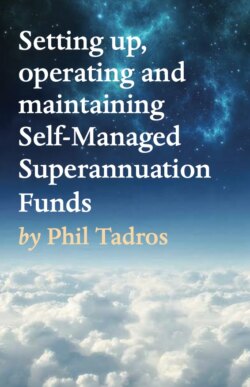Setting up, operating and maintaining Self-Managed Superannuation Funds

Реклама. ООО «ЛитРес», ИНН: 7719571260.
Оглавление
Phil Tadros. Setting up, operating and maintaining Self-Managed Superannuation Funds
Chapter 1 - Introduction
References:
Chapter 2 - Setting up your SMSF
References:
Chapter 3 - Adding Funds to your SMSF
Chapter 4 - The SMSF Investment Strategy
References:
Chapter 5 - Different phases in your SMSF
Transfer balance cap
References:
Chapter 6 - Investing and taxation issues in your SMSF
Chapter 7 - Borrowing in your SMSF
Chapter 8 - Taxation on Super Pensions & Death Benefits
References:
Chapter 9 - Annual financial accounts and the audit report
Chapter 10 - The SMSF Annual Tax Return
References:
Chapter 11 - Winding up your SMSF
References:
Concluding Remarks
Отрывок из книги
Superannuation is like a savings account used to put money aside for taxpayers (individual people) until they reach retirement or preservation age. The superannuation money is usually paid by an employer towards a nominated superannuation fund of the employee, and this amount is set at 9.5% of the total gross earnings of the employee. The ever growing Self-Managed Superannuation Fund (SMSF) industry in Australia is a way for individuals to have more control over their retirement money in terms of investing in different assets, or different classes of assets, which other industry superannuation funds are less likely to invest in, or have a direct investment in.
There are two different authorities that govern superannuation in Australia. The body that oversees the large industry superannuation funds, such as HESTA, Host Plus, CBUS, is the Australian Prudential Regulation Authority (APRA). The body that governs, or oversees the SMSFs is the Australian Taxation Office (ATO).
.....
Later on, you can also create a share trading account in the name of your SMSF, preferably with the same bank that your SMSF account is in. Otherwise, you can use a broker if you have a good relationship with one, but usually the brokerage fees will be a little higher and there will be advisory and administration costs.
Previously in this section, you read about a corporate, or company trustee and an individual trustee/s. What is the difference, and what are the pros and cons of having either as trustee for your SMSF?
.....